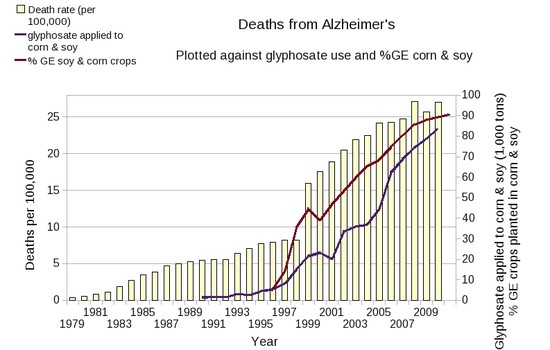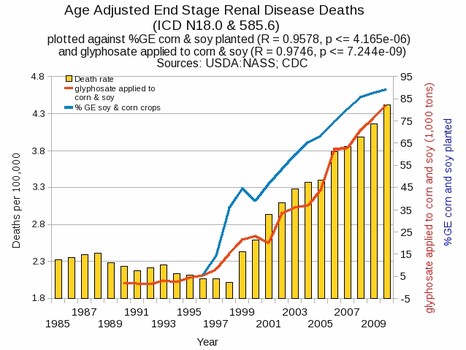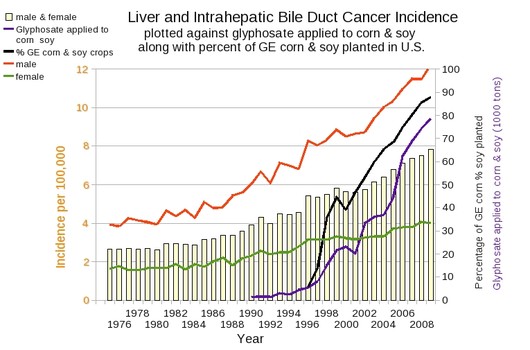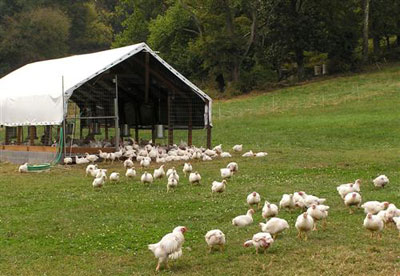A month or two ago, someone gave us a used egg carton from another egg company. On the front of its full-color label, the company proudly advertised: “No Antibiotics!”
Technically, they were right. Technically, however, they were very wrong. In 2010, Monsanto patented glyphosate (commonly known as “Roundup”) as an antibiotic. Glyphosate is the #1 herbicide in the US, with 180-185,000,000 pounds of glyphosate used in 2007 (the latest year that the EPA gives statistics for). To put that in perspective, “regular” antibiotics used in agriculture totaled almost 29,000,000 pounds in 2009. In other words, over 6 times more glyphosate was used than regular antibiotics.
But glyphosate is no ordinary antibiotic. It might be called a “reverse antibiotic”. It kills good bacteria, such as those that inhabit our intestines—and stimulates harmful bacteria. And it was this antibiotic that was being fed to the chickens who laid the “no antibiotics” eggs!
For years, Monsanto advertised Roundup as “safe” and “biodegradable” and told us it was neutralized when it touched the soil; that is, until they got in legal trouble because the facts didn’t line up with their claims. Roundup is a chelating agent that binds with other substances and makes them unavailable. When glyphosate binds with clay particles in the soil, it is immobilized and remains attached to that clay particle until it either breaks down (a process that can take years) or is released in the soil. Therefore, repeated applications of Roundup have the potential to accumulate in the soil.
In 1996, genetically engineered crops hit the market, and by 2012, around 90% of the corn and soy grown in the US were GMO. Most of these crops are designed to be sprayed with Roundup while they are growing to kill weeds growing in the field, without killing the crop. Now, instead of only spraying their fields prior to planting, farmers could spray Roundup at any time they desired. What this means is that a systemic antibiotic (glyphosate/Roundup) is being sprayed directly on our food, absorbed by the plants and spread throughout their tissues. Roundup is also sprayed pre-harvest on crops such as wheat, barley, sugarcane and lentils to control weeds and to get uniform dry-down of the plants.
And? Does it matter?
In 2012, Gilles-Eric Séralini and his team of researchers shocked the world with graphic pictures of rats with huge tumors from exposure to Roundup Ready foods and Roundup.

From left to right: a rat fed GMO corn grown without Roundup; a rat fed GMO corn grown with Roundup; a rat given non-GMO corn, with a trace amount of Roundup in its drinking water.
“Séralini designed his 2012 study as a direct followup of a previous study on the same NK603 maize conducted by Monsanto to support its application for regulatory authorization…
“Séralini’s findings were alarming: both GM maize NK603 and Roundup caused serious kidney and liver damage and an increased and earlier development of tumours, leading to an increased rate of mortality.
“These serious effects had not shown up in Monsanto’s 90-day test because it was too short. Serious diseases like organ damage and tumours take time to develop and become obvious…
“…in Séralini’s study the first large tumours were only seen four months into the trial in the case of males and seven months in the case of females. Most tumours were only detected after 18 months...
“Ninety days in a rat is equivalent to only 7–9 years in human terms – yet human beings could eat a GM food and residues of Roundup over a lifetime.” (emphasis mine)
http://www.gmoseralini.org/faq-items/why-this-study-now/
By the beginning of the 24th month of the study, 50-80% of all female rats had developed tumors in the GMO- and Roundup-exposed groups—with some rats having up to 3 tumors.
It is important to note that increased tumors and organ damage were found in rats who were given Roundup in their water with no GMO feed. In other words, Roundup by itself, without GMO grain, has the potential to do great damage to the body, even at very low doses. (The lowest dose was intended to mimic the minute trace amount found in some tap water.)
But the potential damages of Roundup go beyond tumors. As noted earlier, Roundup is very toxic to gut bacteria, which are important for proper digestion of food. Glyphosate also inhibits enzymes that the body uses to detoxify itself and produce bile acids for digestion of food. This means that, by destroying the body’s natural defenses, Roundup can enhance the effects of other toxins we absorb from our food and environment. It also means that Roundup can cause the digestive system to work less effectively than it should.
In other words, we see a one-two punch here: destruction of gut bacteria and reduction of digestive function. When the bowel is malfunctioning, we are unable to absorb all the minerals and vitamins that we need from our food. This can lead to all kinds of disease. Researchers Anthony Samsel and Stephanie Seneff have shown the great possibility of a link between glyphosate and many different diseases, including gastrointestinal disorders, obesity, diabetes, heart disease, depression, autism, infertility, cancer and Alzheimer’s disease. (See link at the end.)
But is this actually happening in our society? Is Roundup actually causing disease, or is this empty hypothesizing? Nancy Swanson, former staff scientist for the US Navy, has plotted the rise in the use of glyphosate against the rise in various diseases. The graphs are significant:



Compare this graph with the following one showing the total amount of sweeteners used over the same time period (top, purple line). The total amount of sweeteners used has actually dropped while diabetes has risen:



The last two graphs are very interesting, because they go right along with the findings of Séralini’s rat study: liver and kidney damage. The renal (kidney) disease graph is particularly interesting, because it shows the disease rate dropping right before the introduction of GMO’s and increase in glyphosate usage –with a sharp spike afterwards. I encourage you to look at all the graphs:
http://www.examiner.com/slideshow/gmos-glyphosate-and-neurological-disorders
http://www.examiner.com/slideshow/glyphosate-gmos-and-disease
http://www.examiner.com/slideshow/incidence-rates-of-thyroid-cancer-new-cases-reported-per-year-per-100-000
How much glyphosate are we actually getting in our food? After all, the government has set limits on the level of glyphosate in our food. But how do we know if anyone is actually abiding by those standards? Samsel and Seneff state:
“It is difficult to get information on actual amounts of glyphosate present in foods, due to the perception that it is nontoxic to humans [1,6]. The USDA Pesticide Data Program (PDP) is a voluntary program which randomly monitors agricultural chemical residues in the food supply. A search of the most recent data for 2010, published in May 2012, found statistics for the most popular agricultural chemicals except for glyphosate and glufosinate, another organophosphate. Residue data for the most popular herbicide on the planet were not available, but, interestingly, information on atrazine and other herbicides were readily available. Communication with USDA revealed that no data were available due to lack of monitoring. However, in 2013, for the first time, the USDA will be releasing a small amount of data for glyphosate residues only in soy. Lack of program funding was cited as the reason for this lack of data.” (emphasis mine)
The National Pesticide Information Center confirms this:
“Glyphosate was not included in compounds tested for by the Food and Drug Adminstration’s (FDA) Pesticide Residue Monitoring Program (PRMP), nor in the United States Department of Agriculture’s Pesticide Data Program (PDP).”
http://npic.orst.edu/factsheets/glyphotech.html
It’s strange that the government is not testing for the #1 agricultural chemical in America! Obviously, if you don’t look for it, you won’t find it. With glyphosate being sprayed all over our food, there’s no telling how much the average American ingests on a daily basis. Those 185 million pounds of glyphosate have to go somewhere.
One thing is certain: we are eating glyphosate. A recent German study found glyphosate residues in the urine of dairy cows, rabbits and humans. These people and animals were not just consuming glyphosate-contaminated food, but were actually absorbing the glyphosate into their bloodstream and circulating it throughout the whole body. Not surprisingly, glyphosate residues were significantly lower in people eating an organic diet than those eating a conventional diet. One very interesting finding was that chronically ill humans had significantly higher levels of glyphosate in their urine than healthy humans.
Furthermore, this study also found that glyphosate accumulates in animal tissue. Tests of kidney, liver, lung, spleen, muscle and intestinal tissue all revealed similar amounts of glyphosate residues. Glyphosate is accumulating in the meats that we eat—to be passed along for our second-hand consumption. The logical conclusion is that glyphosate residues are also accumulating in our own bodies. (See more at http://omicsonline.org/open-access/detection-of-glyphosate-residues-in-animals-and-humans-2161-0525.1000210.php?aid=23853)
What are we to do? If the government won’t protect us, who will? You. We must each take our own health in our own hands and get serious about removing this toxic antibiotic from our diet if we don’t want to be included on those graphs of disease. This starts with the cereal you eat for breakfast, the sandwich you eat at lunch and the chicken you eat for dinner. If it’s not organically raised, assume it has glyphosate residues. This includes the tortilla chips that are made with organic corn and fried in conventional, glyphosate-treated vegetable oil. Since the glyphosate residues are part of the food itself, they cannot be washed off, and they are not broken down by cooking.
It is important to cut through the chatter and find truly organic food. Be discerning and ask questions. One farm about an hour from us claims to “go beyond organic”—yet they told us that they used GMO feed for their animals. Other farms, recognizing the dangers of GMO’s, use non-organic, GMO-free feed. However, GMO-free is not necessarily glyphosate-free. It is standard practice for many farmers to spray their fields with Roundup before planting to kill weeds. According to the National Pesticide Information Center, “Lettuce, carrots, and barley contained glyphosate residues up to one year after the soil was treated with 3.71 pounds of glyphosate per acre.” Given that the Séralini rat study showed increased disease in rats who consumed only 0.1 parts per billion of Roundup in their drinking water (i.e., one drop in over 130,000 gallons of water), even a small amount of glyphosate residue is problematic.
Some organic farms, due to the cost of organic feed, feed their chickens conventional feed. They cannot call the chicken or eggs organic, but they can say it was raised on an organic farm. Take nothing for granted!
Fourteen years ago, during our first year of farming, we switched to organic feed for our chickens. This currently means paying over three times more for our feed than if we used conventional feed, but we don’t regret our decision. It is part of our quest to give you healthy, nourishing food that helps you to live better and stay out of the doctor’s office.
I encourage you to make the hard choices. Stop feeding yourself antibiotics that kill the “good guys” and help the “bad guys”. Buy real. Buy healthy. Buy glyphosate-free!
References and recommended reading
Website about the Séralini rat study:
http://www.gmoseralini.org
Articles by Anthony Samsel and Stephanie Seneff:
http://people.csail.mit.edu/seneff/Entropy/entropy-15-01416.pdf
http://www.ncbi.nlm.nih.gov/pmc/articles/PMC3945755/
A Mercola review of Samsel and Seneff’s findings:
http://articles.mercola.com/sites/articles/archive/2013/06/09/monsanto-roundup-herbicide.aspx
Analysis by Nancy Swanson:
http://sustainablepulse.com/wp-content/uploads/GMO-health.pdf
Glyphosate residues in urine:
http://omicsonline.org/open-access/detection-of-glyphosate-residues-in-animals-and-humans-2161-0525.1000210.php?aid=23853




 Not only does the exercise give our chickens more flavor, but the fat that gives it flavor is a good fat. The fat is in a meat that has been able to get omega-3’s from the grass and store those omega-3’s in the fat. The exercise gives the chicken meat a more firm texture, but it is still tender and a good eating experience.
Not only does the exercise give our chickens more flavor, but the fat that gives it flavor is a good fat. The fat is in a meat that has been able to get omega-3’s from the grass and store those omega-3’s in the fat. The exercise gives the chicken meat a more firm texture, but it is still tender and a good eating experience.






